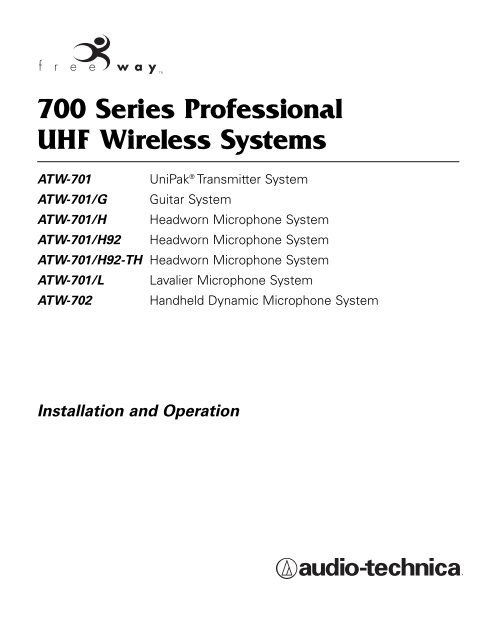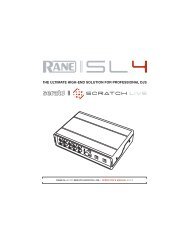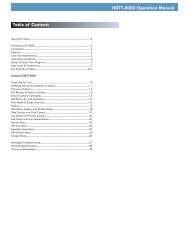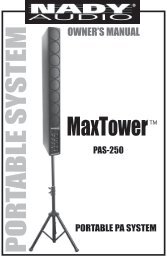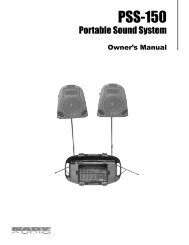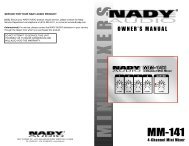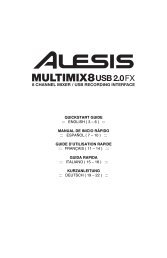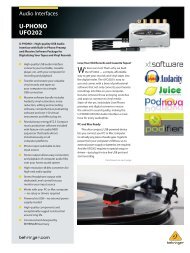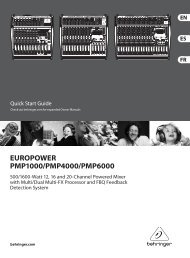700 Series OM - Audio-Technica
700 Series OM - Audio-Technica
700 Series OM - Audio-Technica
Create successful ePaper yourself
Turn your PDF publications into a flip-book with our unique Google optimized e-Paper software.
<strong>700</strong> <strong>Series</strong> UHF Operating FrequenciesEach transmitter/receiver system operates on a choice of eightswitch-selected frequencies. Available frequencies are shown inthe chart. All frequencies may be combined for up to 8simultaneous operating channels.<strong>700</strong> <strong>Series</strong> Frequency Channel PlanChannel Frequency - MHz TV Channel1 542.125 262 545.7503 551.500 274 552.0005 557.875 286 559.3757 560.500 298 561.250Specifications †OVERALL SYSTEMUHF Operating Frequency 542.125 MHz to 561.250 MHzNumber of Channels 8Frequency Stability±0.005%, Phase Lock Loop FrequencycontrolModulation ModeFMMaximum Deviation±25 kHzOperating Range200' typicalOperating Temperature Range 40º F (4ºC) to 110º F (43º C)Frequency Response100 Hz to 12 kHzRECEIVERReceiving SystemImage RejectionSignal-to-noise RatioTotal Harmonic DistortionSensitivity<strong>Audio</strong> OutputUnbalancedBalancedOutput ConnectorsUnbalancedBalancedPower SupplyDimensionsNet Weight 12.9 oz (365 g)Accessory IncludedPower supplyAntenna Switching Diversity55 dB minimum>80 dB at 10 kHz deviation (IECweighted), maximum deviation 25 kHz≤1% (10 kHz deviation @ 1 kHz)25 dBµV (S/N 60 dB at 10 kHz deviation,IEC-weighted)211 mV (-13.5 dBV) (1 kHz modulation,10 kHz deviation)150 mV (-16.5 dBV) (1 kHz modulation,10 kHz deviation)1/4" TS (“mono”) phone jackXLRM-type100-240 VAC (50/60 Hz) to 12V DC 1A(center positive) switched mode, externalpower supply7.48" (190.0 mm) W x 1.65" (42.0 mm) Hx 5.12" (130.0 mm) DUNIPAK ® TRANSMITTERRF Power OutputHigh: 10 mW; Low: 5 mWSpurious EmissionsUnder Federal RegulationsDynamic Range>100 dB, A-weightedInput ConnectionsHigh impedance, Low impedance, BiasBatteries (not included)Two 1.5V AA AlkalineCurrent ConsumptionHigh: 140 mA; Low: 130 mA, typicalBattery LifeApproximately 8 hours (High); 10 hours(Low), depending on battery type and usepatternDimensions2.56" (65.0 mm) W x 4.13" (105.0 mm) Hx 0.73” (18.5 mm) DNet Weight (without batteries) 2.8 oz (80 g)HANDHELD TRANSMITTERRF Power OutputSpurious EmissionsDynamic RangeMicrophone ElementBatteries (not included)Current ConsumptionBattery LifeDimensions10 mWUnder Federal Regulations>100 dB, A-weightedDynamic UnidirectionalTwo 1.5V AA Alkaline120 mA, typicalApproximately 12 hours depending onbattery type and use pattern9.65" (245.0 mm) long, 2.11" (53.5 mm)diameterWeight (without batteries) 9.1 oz (257 g)Accessory IncludedAT8456a Quiet-Flex stand clamp†In the interest of standards development, A.T.U.S. offers full details on its test methods toother industry professionals on request.Specifications are subject to change without notice.7
Ten Tips to Obtain the Best Results1. Use only fresh alkaline batteries. Do not use “generalpurpose” (carbon-zinc) batteries.2. Position the receiver so that it has the fewest possibleobstructions between it and the normal location of thetransmitter. Line-of-sight is best.3. The transmitter and the receiver must be set to the samefrequency. Set or change transmitter frequency onlywhen its power is turned off.4. The transmitter and the receiver should be as closetogether as conveniently possible, but no less than sixfeet (2 m.).5. Yellow LED indicates the channel is set to service position(0 or 9); please select a valid operating channel (1-8).6. The receiver antennas should be kept away from anymetal.8. If the AF Level control of the receiver is set too high, itmay over-drive the input of the mixer or clip the output ofthe receiver, causing distortion. Conversely, if the receiveroutput is set too low, the overall signal-to-noise ratio ofthe system may be reduced. Adjust the output level ofthe receiver so the highest sound pressure level goinginto the microphone (or the loudest instrument playinglevel) causes no input overload in the mixer, and yetpermits the mixer level controls to operate in their“normal” range (not set too high or too low). Thisprovides the optimum signal-to-noise for the entire system.9. In the UniPak ® transmitter, the “Mic” or “Inst” inputcontrol not in use should be set to minimum.10. Turn the transmitter off when not in use. Remove thebattery if the transmitter is not to be used for a period oftime. Unplug the receiver from the AC outlet when thesystem is not in use.7. A receiver cannot receive signals from two transmittersat the same time.For future reference, please record your system information here (the serial numbers appear inside the batterycompartment of each transmitter, and on the bottom of each receiver):Receiver ATW-R<strong>700</strong> S/NUniPak ® Body-Pack ATW-T701 S/NTransmitterHandheld Dynamic ATW-T702 S/NMicrophone Transmitter<strong>Audio</strong>-<strong>Technica</strong> U.S., Inc., 1221 Commerce Drive, Stow, Ohio 44224 330/686-2600 www.audio-technica.comP51836-02 ©2011 <strong>Audio</strong>-<strong>Technica</strong> U.S., Inc. Printed in U.S.A.


